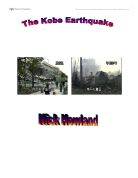arthquake-proofing many of Tokyo’s larger structures remained intact and limited the rising death toll.
Another result of the earthquake was a huge tsunami which hit the shore shortly after the earthquake hit, flooding the harbour. Power cables also fell throughout the city leaving much of the city without electricity, hampering later rescue work. One important fault of the cities construction was that many of the houses were built of wood and quickly burnt to the ground, spreading the growing fire raging throughout the city. There were also no fire breaks, allowing the fire to advance at a very fast rate. Explosions broke out throughout the city when gas mains were broken and stores exploded, causing two-day long fires. This all resulted in a total of 700’000 homes, 9000 factories and roughly 66% of the city being burnt to the ground.
Responses:
Almost straight after the earthquake damage had been repaired the government set about plans to educate the population about earthquakes and so hopefully save many lives if one were to happen again.
-
September 1st was designated ‘Disaster Day, with the whole city practicing drills and simulated earthquakes.
- Schools were made to practice drills regularly in order to educate the young of the city how to best survive.
- People were advised to switch off ovens and stoves so as not to repeat the terrible explosions caused last time thought gas explosions. They were also told not to store things on high shelves, as falling objects are one of the largest killers during an earthquake.
The Japanese realised from past experience and from studying other large earthquakes that the main impact was not the greatest killer, but the aftermath, and so they set up the following in an attempt to save many lives after the next earthquake strikes:
- Emergency water tanks and generators were installed in each district incase of power loss or water contamination.
- Households were given earthquake kits comprising of water, rice, radios and fire extinguishers. All of these items would be invaluable in survival in the aftermath of an earthquake.
Strategies were put into place to improve transport links as the Japanese knew that if their rescue services could not reach those affected by the earthquake, they were no use. Main roads and bridges were improved and strengthened to hopefully withstand the initial impact. A rescue and emergency center was established in an old air base as a last resort option emergency service.
As Tokyo was rebuilt after the earthquake it was made bigger and better. With these changes buildings such as skyscrapers began to appear. These were seen as quite structurally vulnerable if an earthquake were to hit and so the following measures were made to improve their stability:
- Steel frames were built within their structure.
- Cable tension systems controlled by computers were installed to hopefully counteract the swaying motion created during an earthquake.
- Shock absorbers were installed into many of the larger buildings for similar reasons.
- Extra walls were also introduced both inside and out to improve strength and flexibility of buildings.
During the Kanto earthquake of 1923, 66% of the city was burnt to the ground. Fire was the main destructive force of the whole earthquake. For this reason when Tokyo was rebuilt wooden building materials were avoided and open spaces were created to act as firebreaks, preventing the fire spreading any further. Fireproof buildings such as the Shirahige-Higashi apartment were also constructed for similar effect. 543 hectares of housing were strengthened and fireproofed and further areas were demolished to again act as firebreaks within the city.
One of the main reasons for the huge death toll in the Kanto earthquake was because the population were taken thoroughly by surprise. Measures were taken to improve earthquake prediction in the meetings that followed the disaster. Instruments were installed to measure the Earth’s movements. The next earthquake being predicted for 2020. City authorities also promised that next time, the public will be given at least a few hours in order to prepare themselves for the initial impact.







